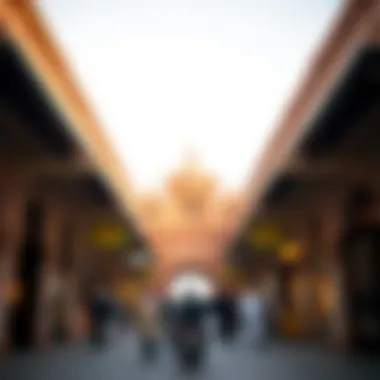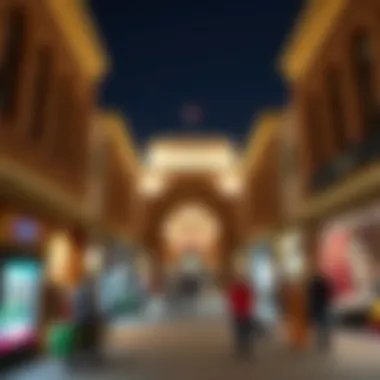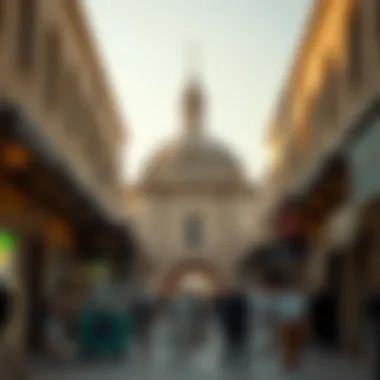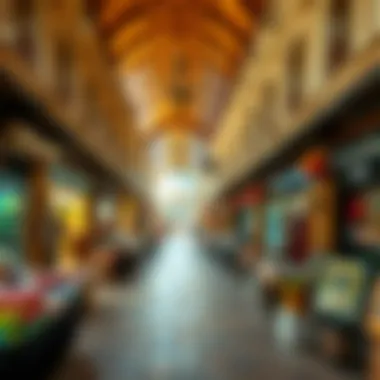Discovering Souk Naif: Dubai's Cultural Marketplace


Intro
Nestled within the bustling heart of Dubai, Souk Naif serves as more than just a marketplace; it embodies the essence of the city's rich history and its vibrant present. The area is an attraction that offers both locals and visitors a glimpse into a world where tradition meets modernity. While wandering through its winding alleys, one can witness a blend of different cultures and a significant part of the emirate's ongoing narrative.
So why does Souk Naif hold such importance? For starters, it’s more than just a shopping hub. The marketplace is a reflection of Dubai's cultural identity, showcasing an array of goods, from traditional Arab clothing to spices and exquisite jewelry. But it doesn't end there; through this exploration, we’ll dive deeper into how this historical site affects the surrounding real estate and offers potential for investment.
This guide aims to illuminate the intricacies of Souk Naif, its influence in the current market, and what it means for prospective investors and residents looking to marry the charm of the old with the opportunities of the new. As they say, "the proof is in the pudding," and this article will serve up a thorough understanding of why Souk Naif is not merely a destination but a gateway to embracing Dubai’s cultural and commercial brilliance.
Prelude to Souk Naif
Souk Naif holds a spot that is more than just a tourist attraction in Dubai. It's like a living museum, echoing stories of the past while intertwining with the present. Located in the heart of the bustling Deira district, this traditional souk––or market––is a veritable gateway to understanding the culture and commerce that defines Dubai. Visitors and locals alike flock here, not solely for the goods on offer but to soak up an atmosphere that's as rich and layered as the textiles sprawled on the stalls.
Location and Accessibility
Finding Souk Naif isn't a challenge; it’s as simple as hopping on the Dubai Metro to reach Al Gubaiba Station or jumping into a taxi. Nestled close to major landmarks like the Dubai Creek and Al Fahidi Historical Neighborhood, it boasts a strategic location that spurs foot traffic from both tourists and residents. The tiny alleys, bustling with vendors, are pedestrian-friendly, making it easy to explore without the hassle of busy roads. Even those unfamiliar with the city’s transport systems can get to Souk Naif with relative ease.
Accessibility Highlights:
- Metro Access: Al Gubaiba Station on the Green Line.
- Taxi Services: Readily available throughout the city.
- Parking Options: Nearby public parking spots can accommodate visitors arriving by car.
Nothing says convenience quite like being a stone's throw away from a plethora of attractions after a day at the souk.
Historical Context
To truly appreciate Souk Naif, one must wander back through decades of history. The market was founded during the major expansion phase of Dubai in the late 20th century. Initially known for its linen and textiles, this souk adapted, reflecting the city's rapid growth and diversification in trade. In those early days, traders came from across the Gulf, bringing with them not only goods but also their unique cultures.
This vibrant tapestry continues today. Each stall and vendor carries echoes of the past. For example, many shops still showcase traditional craft techniques, a nod to the artisans who laid the groundwork. As time passed, the marketplace expanded its offerings to include spices, jewelry, and even textiles from all over the world, creating a melting pot of commercial interests that symbolizes Dubai's global outlook.
An Insight: Souk Naif's blend of tradition and modern commerce illustrates Dubai’s evolution from a humble fishing village to a global crossroads for trade.
Understanding Souk Naif's history enriches the experience for visitors. It isn’t just about shopping; it’s about stepping into a historical narrative that continues to unfold.
In summary, Souk Naif stands as a testament to Dubai's cultural and commercial resilience, inviting those who enter to explore a genuine piece of its legacy.
Cultural Significance of Souk Naif
Souk Naif stands not just as a market but as a vibrant symbol of Dubai's cultural film and its commitment to preserving the traditions that define its identity. In this section, we will explore two principal aspects of Souk Naif's cultural significance: the traditional craftsmanship that flourishes within its stalls and the deep-rooted celebration of local heritage that the souk embodies.
Traditional Craftsmanship
Entering Souk Naif is like stepping into a living gallery where traditional craftsmanship plays a leading role. Here, artisans showcase their skills in various trades that have been passed down through generations. For instance, you can find beautifully handwoven textiles crafted by local artists who pour their heart and soul into every piece, reflecting the rich patterns and colors that tell stories of the region's heritage.
Moreover, the market offers a wide array of items such as intricately designed aluminum artworks, authentic Arabic pottery, and even handmade leather goods. Each item carries the fingerprints of the artisan, adding a personal touch that mass-produced goods simply cannot replicate. This element of traditional craftsmanship not only supports local economies but also fosters a community where skills are shared and nurtured.
One can easily appreciate why visitors are often enticed by the allure of purchasing a unique item that resonates with a sense of belonging to a particular culture. As you wander through the bustling alleys, it becomes clear that Souk Naif is more than a shopping destination; it's a platform where ancient practices are upheld amid the rapid modernization of Dubai.
Celebration of Local Heritage
Souk Naif serves as a cultural haven, celebrating the heritage of Dubai and the wider Middle Eastern regions. Throughout the year, various events and festivals showcase traditional music, dance, and art forms that immerse visitors in the local culture. The souk becomes a stage for performers to keep ancient traditions alive, drawing both locals and tourists who wish to experience authentic cultural manifestations.
Another splendid aspect is how the architecture of Souk Naif itself reflects the rich history of the emirate. The design elements echo the beauty of traditional Arabic architecture, a contrast to the ultra-modern skyscrapers dominating the Dubai skyline. Layers of history are embodied in every arch and every clay-tiled roof.
"Souk Naif is a testament to Dubai's resilient spirit, where the past harmoniously coexists with the present, offering an unfiltered glimpse of the city's soul."


In addition, the souk often hosts workshops where visitors can learn about traditional crafts. These hands-on experiences not only educate participants but also ignite a passion for preserving local artistry. Many attendees leave with a newfound respect for the meticulous work that goes into each craft, making the cultural experience at Souk Naif that much more significant.
As you can see, Souk Naif is crucial for weaving the tapestry of Dubai's cultural narrative. Understanding this significance enriches the experience for everyone who visits, whether for commercial interests or simply to admire the depth of tradition that thrives in this bustling market.
Market Offerings
The essence of Souk Naif is captured in its diverse market offerings, which serve as a microuniverse of Dubai's rich culture and economic vitality. Visitors flock to this bustling marketplace not only to shop but also to experience an ethos that blends tradition and modernity. Each booth and stall tells a story, showcasing unique goods that reflect the region's heritage while meeting contemporary tastes. The market offerings are not just commercial transactions; they’re an exploration of the identity of a city that harmonizes the past and the future.
Textiles and Fashion
When one wanders into Souk Naif, the first thing that strikes the eye is the vibrant tapestry of textiles that line the stalls. From flowing Abayas to intricately designed dresses, the textile options available are as varied as they are beautiful. Shoppers can discover materials—like silk, cotton, and wool—emanating rich colors and complex patterns that hearken back to traditional Emirati designs. These textiles are crafted with such attention to detail that each piece feels like a veritable work of art, allowing wearers to make a unique statement.
Shopping for textiles is not merely a chore; it is an experience that can be savored. Locals often haggle, inviting visitors to take part in this lively custom. Understanding the art of negotiation is essential for new shoppers, as it adds to the overall atmosphere of the souk. The allure lies not just in the purchase but in the interaction itself, where cultures converge.
Traditional Handicrafts
In an age of mass production, the traditional handicrafts available in Souk Naif stand as a testament to skill and artistry. Artisans often showcase their craftsmanship, weaving stories into tangible forms. Visitors can find hand-carved wooden items, intricate silver jewelry, and detailed pottery that encapsulate the spirit of Dubai.
Moreover, the process of crafting these items has been passed down through generations, ensuring that each piece carries a narrative that blends heritage with personal expression. From your typical keychains to elaborate decor items imprinted with Islamic motifs, there is something here that captures the heart of every onlooker.
Craftsmanship in Souk Naif is a shared legacy, a delightful dance between past traditions and contemporary needs.
As consumers increasingly seek authenticity, these crafts provide both a unique shopping experience and a connection to the culture. By acquiring such pieces, visitors play a role in sustaining these time-honored practices, ensuring that the artisans' skills are not lost to history.
Spices and Culinary Delights
A visit to Souk Naif is incomplete without indulging in the aromatic world of spices. At the spice stalls, a plethora of scents greet shoppers, inviting them to explore flavors that punctuate both traditional meals and modern culinary endeavors. Here, one can find saffron, cardamom, sumac, and an array of blends that transform the ordinary into the extraordinary.
The meticulous nature of spice selection cannot be overstated. Each vendor is usually well-versed in the properties and uses of the spices they sell, turning the shopping trip into an interactive exploration. It’s common to engage in conversation, learning about the origins and benefits of particular herbs, allowing the experience to become both educational and flavorful.
Moreover, culinary delights extend beyond spices. Local sweets and dried fruits present themselves alongside practical cooking necessities. With each sample, the rich textural contrast and vibrant flavors excite the palate, leaving an unforgettable impression.
Visitors' Experience in Souk Naif
The heart of any marketplace is the experience it delivers. Souk Naif serves as a vibrant nexus of cultural immersion and commercial exchange, drawing in those who are eager to engage not just with products, but with the essence of Dubai itself. Visitors to this iconic souk find themselves enveloped in a harmonious tapestry of sights, sounds, and smells that echo the deep-rooted traditions of the region. The experience is not merely transactional; it's an exploration of local history and heritage.
Navigating the Souk
Wandering through Souk Naif can feel like stepping into a living museum. The layout is sometimes winding, with narrow paths leading to various stalls and shops. It's important to have a bit of a map—or at least a sense of direction—when navigating these bustling corridors. Here are a few tips for making the most of your visit:
- Start Early: The morning hours allow for a cooler climate and a less crowded market. This can enhance the experience of leisurely browsing.
- Wear Comfortable Shoes: A visit often requires significant walking. Wearing comfortable footwear goes a long way.
- Ask Locals: Don’t hesitate to engage with local vendors. They often share stories that add depth to your shopping experience. Plus, you might get tips on hidden gems within the souk.
As visitors move along the pathways, the atmosphere is alive with the buzz of conversation and the laughter of families. The aromas wafting through the air swirl with exotic spices, fresh produce, and local sweets. Each turn could lead to a unique discovery, whether it be intricate textiles or handcrafted pottery.
Dining Options Within the Souk
No visit to Souk Naif would be complete without indulging in its culinary offerings. Various eateries and food stalls serve an array of traditional dishes that tantalize the taste buds. From flavorful kebabs to steaming bowls of falafel, the options can be overwhelming but in the best way. Here are some popular choices:
- Shawarma: A staple of Middle Eastern cuisine, visitors can find shawarma stalls where meat is grilled to perfection. Each bite delivers a burst of spices and flavors that encapsulate the essence of the region.
- Mezze Platters: For those wanting to sample a little bit of everything, mezze options present a great choice. These platters typically include items like hummus, tabbouleh, and olives, serving as a delicious introduction to Middle Eastern flavors.
- Sweets and Treats: Don’t forget to indulge your sweet tooth with some traditional desserts. Baklava, with its rich, sweet layers of nuts and honey, is a popular choice, often sold fresh at many stalls.
"Food at the souk is not just about fuel; it’s an experience—each dish tells a story of culture and tradition."
As kiosks and restaurants bustle with activity, the multicultural blend of visitors adds an extra layer of vibrancy to the dining experience. Whether enjoying a quick snack at a street vendor's corner or sitting down for a meal in a cozy little cafe, the atmosphere is relaxed and welcoming. Visitors can savor each dish while soaking in the lively ambiance that makes Souk Naif truly special.


Navigating through this market and indulging in its culinary delights ensures that every visitor leaves not only with goods but also with unforgettable memories.
Architectural Elements of Souk Naif
The architectural elements of Souk Naif not only define its visual appeal but also reflect the cultural essence and historical narrative of Dubai. The intricate design plays a vital role in how visitors perceive this vibrant marketplace. Here, elements such as the layout, facade, and materials contribute significantly to the overall atmosphere, making it a unique destination for both locals and tourists. Investing in properties nearby can also be influenced by these architectural characteristics, as they highlight the grandeur and heritage of the region.
Design Influences
The design of Souk Naif emerges from a distinctive blend of traditional Arabian aesthetics and contemporary influences. The souk is characterized by several key elements:
- Open-Air Layout: The design allows for natural ventilation and provides a glimpse into the bustling atmosphere, encouraging interaction among artisans, merchants, and customers.
- Arched Entrances: Iconic arched doorways, common in Arabian architecture, create a sense of grandeur while inviting foot traffic. These arches offer a shady respite from the sun and are often adorned with local artwork.
- Decorative Elements: Unique tile work and ornamental details are strategically placed throughout the marketplace, echoing the region's artistic heritage.
- Use of Natural Materials: Building with local materials like stone and wood not only showcases craftsmanship but also contributes to the sustainability of Souk Naif.
These influences help create a space that is not just functional but also reflects the essence of Emirati culture. The harmony of traditional and modern elements often attracts prospective property owners and investors looking to tap into the area’s burgeoning real estate market.
Sustainable Architecture
Sustainability is becoming a critical consideration in architecture, and Souk Naif showcases several principles aimed at minimizing environmental footprints. The move toward sustainable architecture here includes:
- Energy Efficiency: Structures are designed with passive cooling techniques, utilizing shading and ventilation to reduce reliance on air conditioning.
- Water Conservation: Installation of water-efficient fixtures aims to minimize waste, while landscaping includes native plants that require minimal irrigation.
- Recyclable Materials: Emphasis on using renewable and recycled materials in construction resonates with the global movement towards sustainable designs.
- Community Space: The layout provides communal areas that engage visitors and during events, fostering a sense of belonging and community.
By integrating these sustainable practices, Souk Naif not only preserves its cultural integrity but also sets an example for future developments in Dubai. The commitment to such architectural principles may influence local property values, offering potential investors a unique opportunity to contribute to a marketplace that respects both its past and its environmental responsibilities.
"The architecture of Souk Naif stands as a testament to Dubai's ability to balance its cultural values with modern demands, turning it into a focal point for economic and social interaction."
As Souk Naif continues to evolve, its architectural elements will remain a crucial factor in shaping its identity and influence within Dubai's broader commercial landscape.
Souk Naif and Real Estate Trends
The relationship between Souk Naif and the surrounding real estate market is a fascinating one, serving as a barometer for Dubai's evolving commercial and cultural landscapes. Souk Naif not only provides a unique shopping experience but also heavily influences local property values and investment trends. Investors, homeowners, and market analysts alike should closely follow these dynamics to understand how they can navigate this bustling area.
Impact on Local Property Values
Property values in areas surrounding Souk Naif have shown considerable attention over the years. This souk's popularity as a cultural hub tends to uplift real estate prices due to increased foot traffic and interest from both locals and tourists. For instance, properties within walking distance to Souk Naif often attract higher rental yields.
Key factors influencing property values include:
- Accessibility: Being close to a major market like Souk Naif offers convenience for residents. This makes nearby properties more desirable, thus pushing up their market rate.
- Cultural Appeal: As a traditional marketplace, Souk Naif has a unique charm that appeals highly to both expats and tourists. Investments in cultural landmarks often boost demand for residential properties nearby.
- Retail Growth: When shops thrive in Souk Naif, so does the economic viability of the area. This can spur new developments which can lead to a rise in property values.
Reports have shown that residential properties in the vicinity of Abu Baker Al Siddique Road, near Souk Naif, have witnessed price increases by approximately 15% in the past year alone. This uptick reflects the lure of the souk as a shopping and cultural hotspot.
Investment Opportunities Nearby
Investors have a keen eye on Souk Naif not just for its immediate commercial activities but also for its potential growth in nearby property markets. Opportunities abound in this historical district, presenting favorable conditions for various investment types.
Some notable opportunities include:
- Mixed-Use Developments: Combining retail and residential spaces near Souk Naif could cater to the growing demand for lifestyle-centric amenities. Developers finding the sweet spot between commerce and living spaces can capitalize on the foot traffic the souk generates.
- Co-Working Spaces: With the rise of remote work, openings for co-working spaces in close proximity to business districts around Souk Naif is on the rise. Investors may find it lucrative to renovate existing properties to serve this demographic.
- Urban Renewal Projects: There is an ongoing discussion in Dubai about revitalizing cultural spaces and neighborhoods. Investing in properties slated for such transformations could prove profitable in the long term."
"Successful investment is not just about the property you buy but also the community you become a part of.”
In summary, Souk Naif serves as a cornerstone in understanding the real estate panorama of Dubai. Its effects on local property trends and investment potential are significant, deserving attention from anyone interested in the city’s burgeoning market. Following these trends closely could reveal not just short-term gains, but long-lasting impacts on the overall investment landscape.
Challenges Facing Souk Naif


Understanding the challenges that Souk Naif confronts is pivotal for both investors and stakeholders in Dubai’s burgeoning real estate sector. Souk Naif, while steeped in rich cultural significance, faces competition that threatens its position as a cornerstone of local commerce and tourism. Identifying these hurdles can offer insights for potential stakeholders about the longevity and viability of investments in the area.
Competition from Modern Malls
Modern shopping malls have cropped up all across Dubai, showcasing lavish offerings that often overshadow traditional marketplaces. These malls, like The Dubai Mall and Mall of the Emirates, offer not only shopping but also lifestyle experiences, dining, and entertainment under one roof. Their appeal lies in their air-conditioned comfort and the plethora of global brands available. In contrast, Souk Naif, with its traditional charm and local offerings, encounters difficulties in capturing the interest of a demographic that increasingly leans towards convenience and a premium shopping experience.
The allure of modernity means that many consumers might choose the comfort of a mall over a local market, which could lessen foot traffic at Souk Naif. This shift not only impacts sales within the souk but also diminishes its visibility as a destination. To remain relevant, it is critical for Souk Naif to find ways to blend its historical essence with modern retail strategies. This could involve marketing efforts aimed at highlighting unique aspects that modern malls can't replicate.
"The challenge for Souk Naif is to embrace its cultural identity while adapting to the ever-changing retail landscape of Dubai."
Preserving Cultural Integrity
In the face of modernization, maintaining the authentic charm of Souk Naif is of utmost importance. This marketplace embodies the heritage of Dubai, exemplifying traditional craftsmanship and the local culture that many neighborhoods strive to preserve. However, as the commercial landscape evolves, there’s a growing pressure to commercialize certain aspects to attract more visitors.
Balancing modernization with cultural integrity becomes a fine line to walk. On one side, adapting to contemporary commercial needs can bring in revenue, while on the other hand, over-commercialization can erode the unique qualities that define Souk Naif. It raises concerns: How do you keep the market vibrant yet true to its roots?
Investors and local authorities need to work hand in hand to develop strategies that highlight and protect the traditional values of Souk Naif while still ensuring it thrives economically. Initiatives can include community events that promote local artisans, cultural festivals, and educational workshops that allow visitors to engage with the history of the marketplace.
Ultimately, the prosperous future of Souk Naif hinges on its ability to navigate these challenges while offering a unique experience that both locals and tourists cherish.
Future of Souk Naif
The outlook for Souk Naif is pivotal, as it sits at the intersection of tradition and modernity in Dubai. Understanding its future is essential for investors, homeowners, and developers who want to get in on the vibrant market scene. As an iconic destination, Souk Naif isn’t just about shopping; it's about how it shapes and reflects the ongoing culture in a rapidly changing city. This section dives into projected developments and community engagement initiatives, two key elements that will influence Souk Naif’s evolution and relevance.
Projected Developments
Souk Naif is expected to evolve significantly over the coming years, emphasizing the need for sustainable practices and modernization. A few of the anticipated changes may include:
- Upgraded Infrastructure: There are plans to improve accessibility, including better public transport links and enhanced pedestrian pathways. Making it easier for visitors means more foot traffic, which can only be beneficial in the long run.
- Integration of Technology: The introduction of digital platforms for local artisans could change the game. Digital storefronts might allow craftsmen to reach a broader audience, linking them with consumers worldwide. This change isn’t just urban; it's about global reach.
- Expanded Retail Space: The marketplace might see new sections dedicated to contemporary designs, appealing to a younger demographic. This could bridge the gap between the traditional Souk experience and modern shopping habits, catering to both tourists and locals alike.
These developments underline the importance of Souk Naif as more than just a shopping venue. It's a cultural tapestry that needs to adapt to maintain its significance in Dubai’s diverse urban landscape.
Community Engagement Initiatives
The future of Souk Naif won’t only rely on changes made by investors and developers but also local involvement. Community engagement initiatives are crucial for weaving the very fabric of local culture into the marketplace. Here are some ways this could unfold:
- Local Workshops and Art Shows: By hosting regular events that celebrate Emirati culture, Souk Naif could become a hub for cultural exchange. Things like traditional craft workshops or art installations could draw interest from local residents and tourists alike, fostering a sense of belonging.
- Collaborations with Local Schools: Involving schools in activities could bring in fresh perspectives. Student projects based on Emirati history could be showcased within the souk, promoting education and community spirit.
- Feedback Mechanisms: Establishing platforms for visitors and retailers to provide feedback helps ensure that the Souk gets better with time. Engaging the community in decision-making processes also nurtures loyalty.
As a living marketplace, Souk Naif is like a phoenix; it can rise from the ashes of commercial saturation by retaining its roots while adapting to the winds of change.
The future of Souk Naif stands as a testament to the dynamic interchange between past and present in Dubai. Understanding these projected developments and community initiatives can empower investors and stakeholders to position themselves wisely, ensuring that Souk Naif remains a vital part of Dubai's commercial and cultural essence.
End
The exploration and understanding of Souk Naif offers far more than just a glimpse into a bustling market. It illustrates the intricate blend of culture and commerce that defines Dubai. By dissecting various segments of the souk, from its historical roots to its present-day significance, we grasp not only the essence of a market but also the larger narrative about the city itself.
Summary of Insights
In retracing our steps through Souk Naif, several key takeaways can be discerned:
- Cultural Heritage: Souk Naif stands as a testament to Dubai's rich past, showcasing traditional craftsmanship that continues to thrive amid modernities.
- Market Dynamics: The souk is more than just a shopping destination; it's a hub of culinary delights and local artistry, catering to residents and tourists alike.
- Real Estate Influence: The ongoing interest in Souk Naif and its surrounding areas reflects broader trends in Dubai's property market, which investors should keep an eye on.
These insights serve not just as observations but as a foundational understanding for anyone considering investments or engaging with Dubai’s unique offerings.
Final Thoughts on Souk Naif’s Role in Dubai’s Landscape
Souk Naif is truly a microcosm of Dubai’s multifaceted identity. Its tenacity in retaining cultural significance while serving as a commercial powerhouse showcases the delicate balance between heritage preservation and economic growth.
As Dubai evolves, the souk remains a vital cog in the wheel. It’s a living canvas where tradition meets innovation, and for investors, real estate agents, and local residents, its future beckons with promise. Engaging with this space provides not only a commercial opportunity but also a chance to connect deeply with the spirit of Dubai. The continued support of initiatives that highlight and promote its cultural integrity ensures Souk Naif remains a vibrant part of Dubai's landscape for generations to come.











